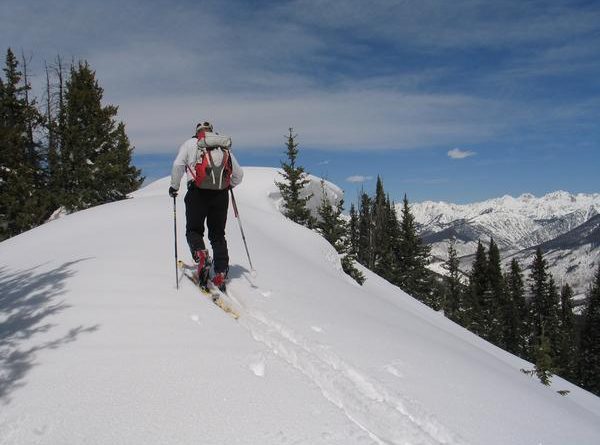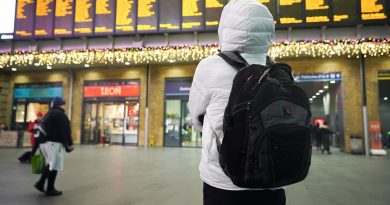Want to try backcountry skiing in Colorado? Read this basic guide first.
Visualize being at the summit of a ski resort on a bluebird powder day, surrounded by a glorious panorama filled with snowcapped peaks glistening in the distance. Now imagine you and a few ski buddies have the mountain to yourselves. No lifts, no overcrowded dining halls with over-priced burgers, just you and your crew.
With the proper equipment and training, you can have that experience as a backcountry skier. And if climbing mountains on skis sounds too adventurous, imagine climbing a quiet forest trail with a mellow grade on cross-country skis, the only sounds coming from your breathing and the whoosh-whoosh whisper of the skis beneath you. That, too, can be yours on backcountry gear.
“Backcountry skiing is an amazing sport,” said Jeff Woodward, co-founder and CEO of Bluebird Backcountry, a ski area 30 miles north of Kremmling that functions as a training ground for backcountry skiing and snowboarding. “You can get away from the crowds and be out in nature and have a great time, hopefully with family or friends, but still be skiing or snowboarding. It can be life-changing.”
Backcountry touring comes with different types of gear and techniques suited for different kinds of terrain.
“Backcountry skiing takes a lot of forms, everything from adventurous mountaineering to simple touring around woods,” said John Weir, marketing manager at Bentgate Mountaineering in Golden.
We’ve pulled together some things to know if the backcountry is calling you, whether you are a skier or snowboarder. Some of it will apply to snowshoers, too.
But please note, the following is not “everything you need to know”; rather, it’s an overview for the uninitiated. We’ll start with some basic vocabulary:
Cross country touring: This is simply cross-country skiing on lightweight skis designed for the backcountry rather than track-set Nordic centers. The main difference is that cross-country skis designed for touring in the backcountry have metal edges for added control on firm or icy trails. Cross-country touring may be an option on some of your favorite summer hiking trails or dirt roads that are closed in the winter. These tours can be fairly strenuous or very mellow and relaxing. Because your heels aren’t locked down, you need to know how to make turns on cross-country gear.
Ski mountaineering: The Colorado backcountry is full of peaks that are a joy to ascend and descend on alpine touring skis, or splitboards for snowboarders. It’s adventurous, strenuous and potentially deadly if you don’t get training in avalanche risk assessment.
Alpine touring skis: These are downhill skis with bindings that have different settings for climbing and descending. The rear binding is designed to unlock the back of the boot for free-heel uphill movement. When it’s time to descend, the rear binding is adjusted to lock down the heel so skiers can use the same downhill turning technique they utilize at ski areas.
Splitboards: Imagine a snowboard cut in half from tip to tail. For uphill travel, there’s one piece on each foot for hiking. For descents, the halves are latched together as one unit to perform like a snowboard.
Climbing skins: Alpine touring gear and splitboards require applying adhesive strips of fabric to the bottoms for uphill travel. Skins have one-directional bristles which allow the skis and boards to keep from slipping backward while climbing. They are removed for downhill travel. They are called skins because they used to be made from animal hides.
Backcountry skiing not only provides access to peaks and trails far from the crowds and expense of resort skiing, but it also offers magical overnight trips thanks to a network of more than three dozen backcountry huts in the Colorado mountains. Most of them are managed by the non-profit 10th Mountain Division Hut Association. Don’t let the word “hut” make it sound like you’d be roughing, though. Most of them are gorgeous cabins with stoves for warmth and cooking. They also have photovoltaic lighting.
Backcountry skiing or snowboarding requires at least an intermediate level of technical ability, but you don’t need to be an expert.
“Even if you’re only comfortable on blue runs, but you are able to ski some blue runs on ungroomed snow, you can still have a really fun day in the backcountry,” Woodward said. “You don’t have to be an amazing skier to ski backcountry, as long as you can ski ungroomed snow.”
So how does a never-ever skier learn how to take up backcountry skiing? One way is to hire a guiding company such as Colorado Adventure Guides, based in Summit County, or sign up for a class with Colorado Mountain School in Estes Park. The Colorado Mountain Club teaches a course in Introduction to Backcountry Skiing and Splitboarding. It involves two lectures and a field day of on-snow training.
Another option is Bluebird Backcountry, which provides its visitors with a non-threatening backcountry setting, including a ski patrol that conducts avalanche control.
Bluebird, now in its third full season of operation, offers three levels of basic lessons designed to unfold in progression — Intro to Backcountry, Backcountry Skills and “Avalanche Prep.” That last step isn’t designed to tell backcountry travelers everything they need to know about avalanches, though. That requires a much deeper level of training.
Bluebird, Colorado Mountain School and Colorado Adventure Guides offer avalanche training from instructors certified by the American Institute for Avalanche Research and Education (AIARE), but there are many more in Colorado. The AIARE website lists dozens of Colorado locations.
Colorado, which has a notoriously unpredictable snowpack, had seven avalanche fatalities last winter and 12 the previous winter. Backcountry travelers in avalanche terrain should carry electronic beacons, probes and shovels in case an avalanche buries someone. They should always consult the Colorado Avalanche Information Center for its daily avalanche and weather forecasts. CAIC rates backcountry avalanche risk on a five-level scale: low, moderate, considerable, high and extreme. That forecast can help backcountry travelers determine where and when it’s relatively safe to head out.
“You can be more casual or less adventurous about your backcountry skiing,” Weir said, “but anytime you step out of the car, you have to consider what the (slope) aspects are.”
Subscribe to our weekly newsletter, The Adventurist, to get outdoors news sent straight to your inbox.
Source: Read Full Article






